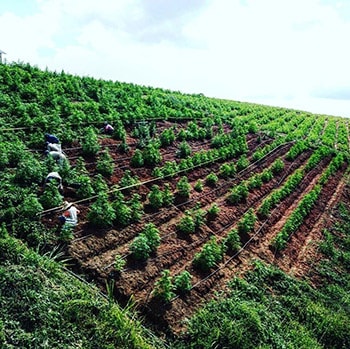<![CDATA[
OTTAWA, Ontario, June 8, 2021 – PRESS RELEASE – HEXO Corp. is proud to announce a commitment to offsetting the company’s operational carbon emissions and the personal emissions of all 1,200 employees*, making HEXO 100% carbon neutral from September 2021 onward. The company is also committing to offset the plastic used in its pouch packaging through Plastic Bank in partnership with Dymapak, HEXO’s primary packaging supplier. These concrete actions highlight the company’s early steps toward a long-term commitment to leading the cannabis industry on Environmental, Social and Governance (ESG) action.
“We have always taken our responsibility for sustainability seriously. Now, as we are on the verge of becoming the top Canadian LP by recreational market share and continuing down the path towards top three globally, it’s more important than ever to take meaningful action to protect our planet—and this is just the start,” HEXO CEO and co-founder Sebastien St-Louis said. “We are challenging ourselves and the rest of the industry to do better, so in addition to becoming carbon neutral by offsetting our operational emissions, we feel it is our obligation to offset our employees’ emissions as well.”
Through a partnership with Canadian carbon management solutions company Offsetters, in support of the Great Bear Forest Project, HEXO will be measuring and offsetting the company’s corporate carbon emissions starting with its 2020 calendar year, making HEXO 100% carbon neutral by September 2021, as well as offsetting its employees’ personal emissions. The GreatBear Forest Carbon Project reduces carbon emissions by protecting forests previously designated, sanctioned or approved for commercial logging. Carbon finance supports the local First Nations communities by generating stewardship jobs protecting the Great Bear Rainforest—the largest intact coastal temperate rainforest remaining in the world—and offsets the equivalent of one million tonnes of carbon dioxide each year.
“On top of their own commitment to carbon neutrality, HEXO has raised the bar by committing to purchase offsets to mitigate their employees’ personal emissions,” said Dawn Hancock, director of client engagement at Offsetters. “This is the first time we’ve seen a company of this size make this kind of commitment and we hope that it helps to spur stronger commitments from other companies.”
In conjunction with HEXO’s primary packaging supplier Dymapak and its partnership with Plastic Bank, the company has offset 63,000 kilograms of plastic in 2021—the equivalent of over 3.15 million plastic bottles. HEXO will continue to counteract the use of all plastic in its packaging. Plastic Bank builds ethical recycling ecosystems in coastal communities and reprocesses the materials for reintroduction into the global manufacturing supply chain. Collectors receive a premium for the materials they collect to help them provide basic family necessities such as groceries, school tuition and health insurance.
“Ocean plastic is a critical issue with increasing challenges,” Dymapak CEO Ross Kirsh said. “Environmental consciousness has never been more important and we’re proud to partner with Plastic Bank and HEXO to mitigate the impact of child resistant bags and other plastic packaging. It’s our hope that other businesses will turn interest into action by committing to plastic neutrality.”
Offsetting HEXO’s carbon emissions, the emissions of its employees and counteracting the use of plastic packaging are among the latest steps in its company-wide mission to build a business that balances profit, people and planet. HEXO will monitor and publicly report on its greenhouse gas emissions, carbon neutrality and its continued efforts to improve sustainability. This includes minimizing waste at facilities, moving toward a more virtual workforce and reducing carbon emissions at production facilities, as well as exploring new sustainable packaging materials that are more easily recyclable or biodegradable. The recent acquisition of Zenabis and planned acquisitions of 48North and Redecan also offer unique opportunities to integrate sustainable practices and grow the company’s positive impact along with its business.
For more information on these efforts and how the HEXO continues to develop its ESG platform and stakeholder relations to make a positive impact on the communities in which it operates and globally, please visit https://www.hexocorp.com/environmental-social-governance.
*Estimated personal emissions based on the average Canadian’s emissions from heating and powering their homes, driving and food consumption
]]>









